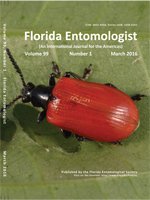Brazilian peppertree, Schinus terebinthifolia Raddi (Sapindales: Anacardiaceae), is one of the most invasive weeds in Florida and Hawaii. In the invaded range, this fast-growing weed from South America poses a threat to agriculture and cattle production and decreases the biodiveristy of natural areas. The thrips Pseudophilothrips ichini (Hood) (Thysanoptera: Phlaeothripidae) is being studied as a potential agent for the biological control of this weed. The laboratory life history and native range of P. ichini in Brazil were examined over 10 yr. The thrips life history includes 2 feeding larval stages that occur on the plant and 3 non-feeding pupal stages that occur in the soil. Development time, body length, and distinct features of each life stage are described. The larva-to-adult development required 20 d, and adults lived for an average of 50 d. Pseudophilothrips ichini had a wide latitudinal range in Brazil along the eastern coast from Bahia (11.4°S) south to Santa Catarina State (27.1°S). It was collected from sea level to 1,329 m elevation. Observations in Brazil indicated that this thrips occurs year round and may occasionally reach high densities (>20 thrips/leaf). Despite searches in its native range of related plants, the thrips was found only on Brazilian peppertree. Considering the short generation time, broad environmental tolerance, host specificity, and damage caused to the host if this thrips is released for biological control, it will contribute significantly to the management of Brazilian peppertree.
How to translate text using browser tools
1 March 2016
Brazilian Collections and Laboratory Biology of the Thrips Pseudophilothrips ichini (Thysanoptera: Phlaeothripidae): A Potential Biological Control Agent of the Invasive Weed Brazilian Peppertree (Sapindales: Anacardiaceae)
G. S. Wheeler,
N. Silverson,
K. Dyer,
F. Mc Kay

Florida Entomologist
Vol. 99 • No. 1
March 2016
Vol. 99 • No. 1
March 2016
Anacardiaceae
biological control of weeds
control biológico de malezas
especies invasivas
invasive species
Schinus terebinthifolia




